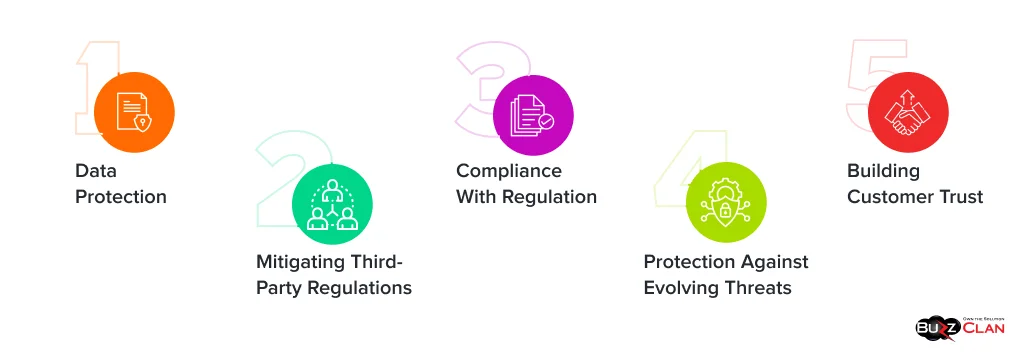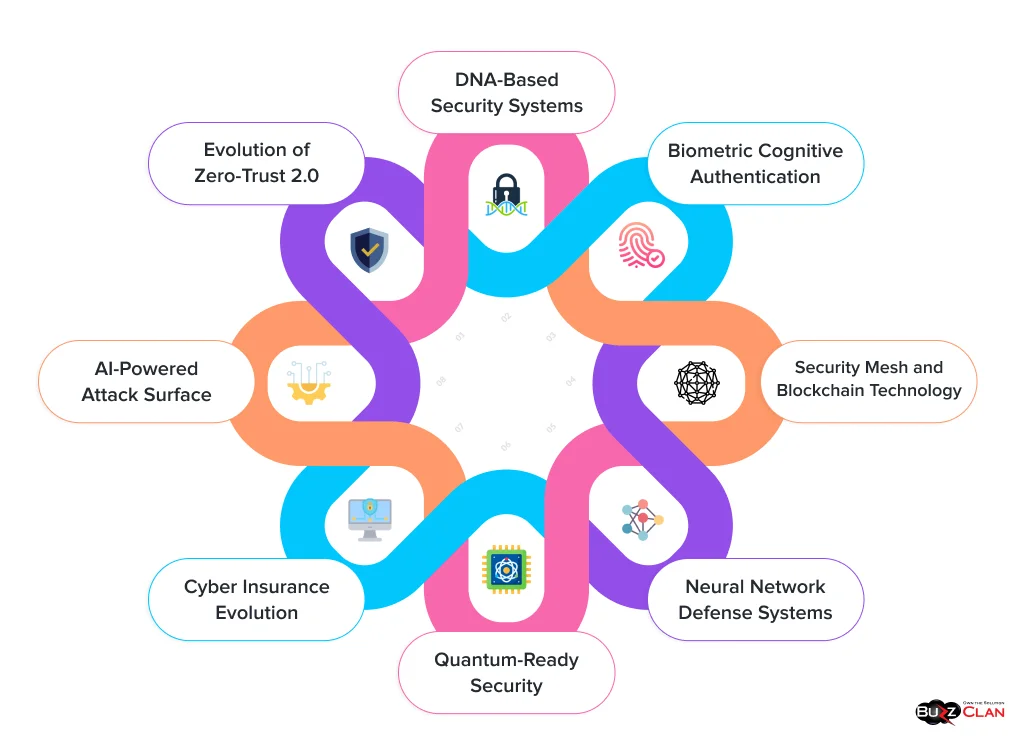2025 Cybersecurity Trends: Navigating the Future of Digital Defense
Sunita Singhania
Dec 26, 2024
What is Cybersecurity?
Cybersecurity is the science of protecting computers, telecommunication networks, and other electronic systems from hackers’ attacks. It refers to a spectrum of technological instruments, activities, and techniques to counteract invasion, theft, or destruction.
Cybersecurity can be broken down into these four main categories:
- Network Security: Safeguarding internet or data networks from cyber threats.
- Application Security: Making sure that applications and devices are safe.
- Information Security: The robust privacy of individuals’ and businesses’ data prevents it from being exposed and misused.
- Operational Security: Ensuring the tasks or operations run securely and protecting data assets.
Let’s explore in detail how cybersecurity is important, what trends and threats to look for, and how they will eventually impact businesses in 2025.
Why Cybersecurity is Important?

Cybersecurity has been in the spotlight in this rapidly growing world at unprecedented speeds. Cybersecurity has immense benefits and the potential to save trillions of dollars worldwide. How can it do so, and why is it so important in the business world? Let’s find out:
Data Protection
Cybersecurity is responsible for securing crucial and sensitive data that can be exposed to hackers and unauthorized people when handled negligently. It protects PII (personally identifiable information), PHI (protected health information), credentials, and other data. Data is of the utmost importance in the digital world, and not taking proper measures to protect it can lead to financial, political, and business losses.
Mitigating Third-Party Regulations
Organizations like Google, Amazon, and Microsoft collaborate and rely on third-party software or applications for operations, like Asana, Slack, and DocuSign. These third parties can misuse your data, and any cyber attack on their organization can also result in the theft of your data. In these scenarios, cybersecurity helps provide high levels of security.
Protection Against Evolving Threats
A famous quote has been modified in the technology world: “With advanced technology comes advanced threats.” Cybersecurity helps secure and protect your system, database, and organization’s network from ever-evolving threats. Some of these threats, such as ransomware-as-a-service, vishing, and phishing, can cause lethal losses to your business.
Compliance With Regulation
Complying with regulations is a must in several industries, such as healthcare, retail, telecommunications, and others. Regulations such as GDPR (General Data Protection Regulation) and HIPAA (Health Insurance Portability and Accountability Act) ensure the data protection of customers and businesses. In this scenario, cybersecurity becomes important for companies because not complying with regulations can lead to fines of up to 50 million dollars.
Building Customer Trust
Which company would you trust? A company that faced one cybersecurity loss but recovered quickly and came back even stronger, or a company that has faced several cybersecurity setbacks and has not improved its security? The answer is already in front of you. Customers (You) will trust only those companies that have suffered fewer cybersecurity attacks or implement cybersecurity measures regularly according to trends. Maintaining cybersecurity standards helps gain customers’ trust, facilitating growth and development.
Top 2025 Trends in Cybersecurity

Did you know cybercrime damages increased from $3 trillion in 2015 to an estimated staggering $10.5 trillion in 2025? In just a decade, technology has evolved significantly, as has cybercrime. To stay secure from cybercrimes, one must know what will happen in the cybersecurity industry in the upcoming year.
Here is the list of the top trends in cybersecurity in 2025, shaping the world and increasing the need for adaptability.
AI-Powered Attack Surface
“AI isn’t just another tool in cybersecurity – it’s becoming the foundation of both offense and defense. The side that better harnesses AI will have a significant advantage.”
These were the words of Sarah Johnson (CSO – TechDefend), showcasing the nature of AI in cybersecurity, similar to a double-edged sword. 2025, the year of AI with its algorithms and tools, will benefit both attackers and businesses.
For attackers, AI has opened the gates to some high-tech, sophisticated vishing and phishing attacks. Discovering zero-day vulnerabilities and crafting authentic deepfakes is just a start for attackers using AI. Moreover, AI-first malware has been seen in current cybersecurity trends, modifying its behavior to evade threat detection. And it’s just starting.
For Businesses, with the help of neural networks, AI will be presenting 99.9% real-time threat detection. Additionally, it will unlock highly advanced predictive analysis with the help of data science and data analysis. With its help, businesses could predict the attacks or threats 48 to 72 hours before the attack.
Evolution of Zero-Trust 2.0
The zero trust model is now evolving into Zero Trust 2.0.
It resembles an always-on monitoring system that checks user behavior and adjusts access levels if something seems off. In contrast, zero-trust is a security guard who checks users’ IDs before granting them access.
In Zero Trust 2.0, authentication happens every 0.5 seconds, making it super fast compared to the predecessor versions. It takes context-aware access decisions, which the model takes by analyzing 200+ behavioral factors with only a 0.3% error rate, i.e., 99.7% accuracy backed up by AI-driven risk scoring.
It provides three times faster threat detection and response than the normal zero-trust security model, eventually evolving the trends in cyber security for businesses and individuals.
DNA-Based Security Systems
What is the highest form of biometric authentication? DNA. When you were a kid, and when someone tried to access something from your stuff, you may have thought of having a key that only you can access, not anyone else, in any possible way. Guess what, now you can!
The concept of DNA-based security systems was introduced in 1994. They can help you store your extensive and confidential data with the most robust key that only one person can ever have—your DNA.
DNA-based security systems utilize DNA data storage and protect your data for up to 2 million years in deep cold storage and over 4000 years under standard laboratory conditions. Computer data is made up of (0 and 1), and DNA is made up of four nucleotides, i.e., adenine (A), cytosine (C), thymine (T), and guanine (G). For converting the digital data into DNA data, the zeros and ones are converted into A, C, T, and G. A = 00, C = 10, G = 01, and T = 11.
Scientists create synthetic lab-grown DNA strands by utilizing this above-discussed data conversion from binary to nucleotides. These strands store 215 petabytes (220160 TB), with an error rate of 1 in 1,000,000 authentications and a self-destruction mechanism when tampered with. Only your DNA, whether hair, saliva, or blood, can access these DNA strands.
Understanding that this extraordinary security system is impossible to break, Microsoft successfully stored and retrieved a GB of data from it in 2015 with 100% accuracy. This security system has the power to reduce costs by 1000x by 2028. Many of the latest developments, like adaptive DNA keys and quantum-DNA hybrid systems, are coming to this security system, fortifying security like never before.
Biometric Cognitive Authentication
Earlier, fingerprints, facial recognition, and voice recognition were effectively used for biometric authentication. However, biometric authentication has also advanced with the advancements in cyber threats. In 2025, we will see a technological advancement known as biometric cognitive authentication, where authentication is done by recognizing cursor movements, keystroke dynamics with 99.3% accuracy, and even how your brain processes information. Yes, your brainwave patterns will be authenticated using noninvasive sensors.
This will assist in enhancing a business’s cyber defense, safeguarding its invaluable data and assets from cyber criminals. Many industries have been implementing this technology gradually, awaiting its boom in the years to come.
Security Mesh and Blockchain Technology
The blockchain market, worth $248.9 billion by 2029, has been proactively used for security purposes. One security technology initiative is blockchain-enhanced security mesh, a self-healing net that secures your enterprise network and other digital assets.
If one part is damaged, the other net quickly heals and automatically covers the damaged area, offering robust and priceless security. With the power to record 100,000+ security events in a second and self-healing protocol activation under 0.05 seconds of a breach, this technology has smart contracts that automatically enforce security policies for better protection.
Alex Thompson (Blockchain Security Architect) has appreciated this tech, saying it revolutionizes how we approach enterprise security. “It’s not just about prevention anymore—it’s about resilience.”
Neural Network Defense Systems
“Neural network defense systems are changing the game from reactive to predictive security. We’re stopping threats before they materialize.” – Lisa Wong, AI Security Specialist.
Neural network defense systems are security systems made from advanced neural networks deployed to craft defense systems that can predict attacks and threats much before they occur. They analyze patterns and behaviors and learn from global threat intelligence in real time to upgrade their intelligence.
They consist of self-learning capabilities that improve accuracy by 2% per month or 0.5% weekly. These systems can predict attacks a day before, and their accuracy is 92%. They have a security event processing potential of 1,000,000 per second.
Businesses’ cybersecurity will eventually be fortified with neural network defense systems. Because of early threat detection, the need to apply cybersecurity measures will be limited, and threats will be eliminated before they create havoc.
Quantum-Ready Security
Think of traditional encryption as a type of lock. However, quantum computing is a type of super master key that can unlock this lock. Now, with the help of quantum-ready security, special types of locks can be made so that even quantum computers can’t break. This is the power of quantum-ready security.
This type of security can restrict ultra-advanced attacks launched by cybercriminals, protecting a business’s super-confidential data and digital assets. Recently, IBM has implied quantum-safe encryption in its cloud services, which has resulted in offering both traditional and quantum-resistant encryption methods.
It doesn’t matter how strong your encryption is; it is estimated that by 2025, quantum computers can break a 2048-bit RSA (one of the strongest encryption systems today) in just 8 hours. Although 99% of Fortune 500 firms are not quantum-ready, this signifies the late adoption of the most prominent companies and the higher chances of cyber attacks.
Cyber Insurance Evolution
Cyber insurance is emerging, just like car insurance. Cyber attacks can destroy businesses’ financial, technical, and legal losses. Cyber insurance covers organizations whenever they suffer cyber attacks, paying for their financial and information losses from IT and network systems.
The cyber insurance industry will be worth $22.5 billion in 2025 and will be boosted and gradually adopted by most industry-leading organizations.
Further Reading
Impact of Cybersecurity Trends 2025 on Businesses
We effectively discussed the future trends in cybersecurity and how they will be amplified in 2025. Let us understand how the latest cybersecurity trends will impact businesses worldwide.
AI-Powered Security
Businesses will also receive more AI-based attacks, including deepfakes, voice, and image manipulation. Organizations must acquire more intelligent protection measures to prevent threats as they are executed in real time.
Zero-Trust 2.0
Better security structures, like zero-trust 2.0, lower the probability of incidents from insiders or unauthorized parties accessing secure data. However, deploying this system will impact businesses’ by requiring ample capital investment and profound adjustment of organizational culture.
DNA Security
Offers highly secure access based on unique DNA identification. Though impressive, its high-end technological implications make it out of reach for most organizations today.
Biometric Cognitive Authentication
It is quite a promising approach to powering cognitive authentication, which would impact businesses by reducing fraud and scams. However, it will also face another problem: user privacy. Without the user’s privacy, no organization can implement these authentication methods, which makes them highly reliable based on customers’ preferences.
Blockchain Security Mesh
It offers system security that cannot be tampered with in distributed systems. This is great news for organizations employing a multi-cloud strategy, but its unique implementation know-how may be required.
Neural Network Defense Systems
These are defense systems based on neural networks. AI systems replicate the brain’s capacity to identify complex risks. Businesses benefit from predictive protection, but this has the disadvantages of high deployment and training costs.
Quantum-Ready Security
Companies must design new encryption models to cope with new threats from quantum advancement. Early adoption preserves data safety but is a race against the clock and money. Quantum-ready security will impact businesses by opening gates to more enhanced security that even the best computers in the world can not break.
Cyber Insurance Evolution
It provides post-cyber event compensation mechanisms. However, increased requirements mean businesses must work hard to improve their classification to meet those criteria.
Key Threats to Look Out for in 2025
After discussing the top trends in cybersecurity, let’s see which are the key threats to whom we must apply these emerging trends. Here is the list of key threats to look out for in 2025, impacting individuals and businesses.
AI-Powered Smart Malware
Nowadays, malware isn’t stupid. It evolves with technology. A real cyber threat that has emerged recently is AI-powered smart malware. These malware programs use artificial intelligence algorithms and can change their code every 30 seconds to bypass detection. They learn from failed attempts and have success rates 300% higher than those of traditional malware.
Launching this malware can result in financial losses and the loss of invaluable customer data, reducing the company’s reputation, market positioning, and overall revenue.
Quantum-Enabled Attacks
Most organizations worldwide are not quantum-ready. Quantum-enabled attacks, which are immediate and super powerful, are key threats to look out for in 2025. They can break into 2048-bit encryption in just 8 hours, making them a super master key that can break any lock (encryption) worldwide.
Moreover, in October 2024, Chinese researchers used a D-Wave quantum computer to launch the first ever successful quantum-enabled attacks, illustrating that this type poses a ‘real and substantial attack.’ Taking cybersecurity measures and utilizing quantum-resistant encryption methods can help businesses bypass these attacks and look for a more secure organizational environment.
Digital Twin Exploitation
A digital twin is a virtual replica of a physical system used for predictive analytics and general simulation. A recent threat related to exploiting digital twins of high-end systems is affecting some industries, including healthcare, energy, smart cities, and others.
Reality Manipulation Threats
By using AR/VR environments, some attacks that manipulate reality by distorting reality completely will emerge in 2025. They are as follows:
- Sensory manipulation attacks
- Memory implantation attempts
- Cognitive override malware
Time-Based Attacks
Time-based attacks disturb the time synchronization in critical and time-sensitive systems. They most likely affect several vulnerable sectors, such as financial trading systems, transportation (subways/trains), and power grid synchronization.
Bio-Digital Viruses
Usually, malware travels from digital devices to other devices. But what if we tell you that malware can jump from computers to human anatomy? Bio-digital viruses enter the human system via computers or medical devices. They manipulate brain-computer interfaces by modifying neural signals and interfering with cognitive functions. Pacemaker interferences are also seen in healthcare industries, where attacks like battery depletion and heart rhythm manipulation are launched, making bio-digital viruses life-threatening and critical.
Quantum-Social Engineering
What if one of the fastest computers in the world is used to launch social engineering attacks? It is one of the key threats to look out for in 2025. Quantum-social engineering attacks are crafted by combining the power of quantum computing with social engineering to launch attacks on businesses. Some examples of quantum-social engineering are Quantum-generated perfect phishing and real-time voice/video manipulation.
Elevate Your Cyber Defense with BuzzClan’s Superior Protection
Partnering with BuzzClan gives you an expert professional team whose sole purpose is to secure your digital assets using the latest tools and tech stack with numerous securities, like IoT and cloud security.
We ‘BuzzClan’– a leading cyber security services provider, understand your unique needs and offer plenty of cybersecurity solutions, such as incident response services, penetration testing, risk management, etc. With a proactive approach, regulatory compliance support, and around-the-clock services, we eliminate cybersecurity challenges and craft customized security strategies, shielding your cyber defense like never before.
To Sum Up
In this blog, we mentioned the cybersecurity trends of 2025. Over the next few years, organizations will implement these trends. Understanding their impacts on businesses and working with them will shield your business from cyber threats.
Knowing both heads and tails of the cybersecurity coin, i.e., trends and threats, will keep you ahead of your competitors, ensuring higher revenue and sustainability. Moreover, if you want to focus solely on operations with a serene mindset, contact us for robust cybersecurity solutions and let us easily eradicate your cybersecurity concerns.
FAQs

Get In Touch
